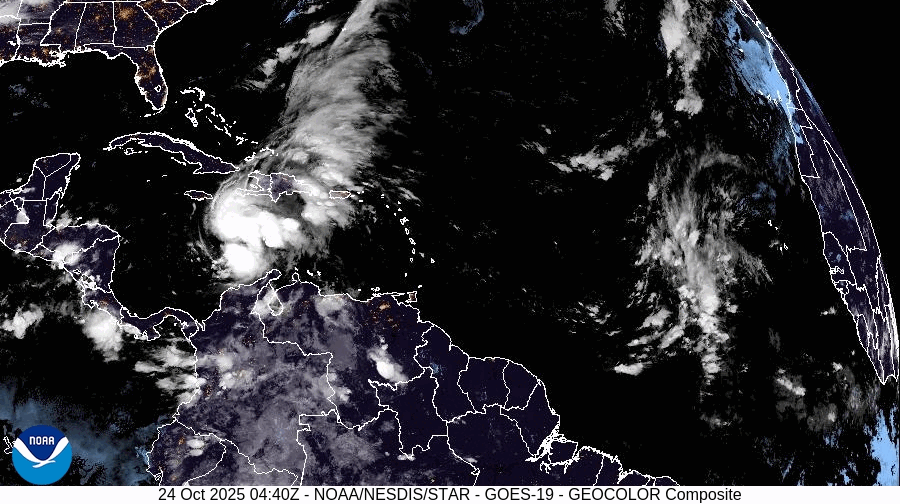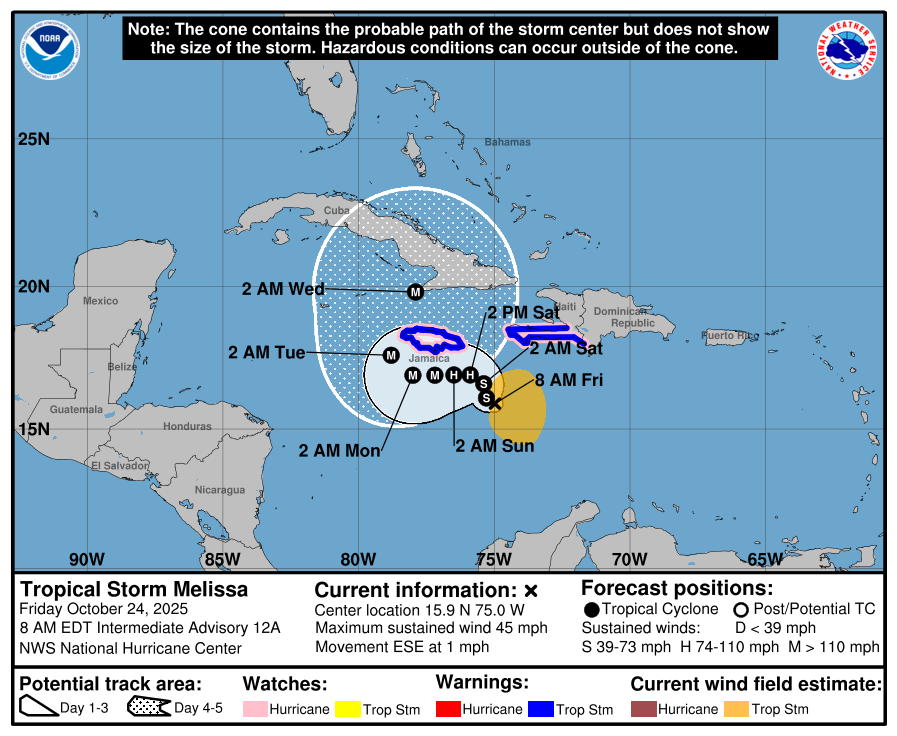'Near stationary' Tropical Storm Melissa is moving slower than a person walking — and it may bring deadly flash floods to the Caribbean
Tropical Storm Melissa is moving at a snail's pace but will intensify rapidly over the weekend as it feeds off near-record-warm water temperatures in the Caribbean Sea, forecasters say.

After circling the central Caribbean Sea and remaining 'near stationary' this week, Tropical Storm Melissa is now about 160 miles (260 kilometers) southeast of Kingston, Jamaica, and drifting southeastward at 1 mph (1.6 km/h).
The storm's bafflingly slow advance, which is projected to stay below an average person's walking speed at around 2 mph (3.2 km/h) over the weekend, could be dire for several Caribbean islands, experts warn.
Tropical Storm Melissa will continue to lumber along a path somewhere between Jamaica and Haiti, with forecasters predicting a slow movement toward the northeast and north in the coming hours, and a westward drift from Saturday (Oct. 25) onward.
Melissa is expected to bring 8 to 14 inches (20 to 35 centimeters) of rain to parts of the Dominican Republic, Haiti and Jamaica through Sunday (Oct. 26) night, with locally higher amounts possible, according to an update from the National Hurricane Center (NHC) at 8 a.m. ET today (Oct. 24).
"Significant, life-threatening flash flooding and numerous landslides are expected in the southern Dominican Republic and eastern Jamaica, with catastrophic flash flooding and landslides anticipated in southern Haiti," representatives wrote. "Across northern Dominican Republic, northern Haiti, and western Jamaica, 3 to 5 inches [8 to 13 cm] of rain are expected through Sunday night. Flooding impacts may increase across western Jamaica next week."
Researchers expect the storm to intensify rapidly into a major Category 3 or above hurricane over the weekend, fueled by near-record-warm Caribbean waters, but the storm is likely to remain incredibly slow-moving, CNN reported.
Melissa is the 13th named storm of the 2025 Atlantic hurricane season. It's unclear exactly what has been stalling it, but a combination of strong upper-level winds and other dampening conditions across weather systems could be responsible, according to CNN. For instance, the lack of a cold front — a wedge of cold air that pushes warmer air up and causes it to release its energy, creating bad weather — might partially explain Melissa's crawling speed.
Get the world’s most fascinating discoveries delivered straight to your inbox.

But Melissa's lagging pace is not as unusual now as it would have been just decades ago. Research indicates that tropical storms are getting slower, particularly as they approach land masses. A 2018 study, for example, found that tropical storms globally slowed by 10% between 1949 and 2016 — and James Kossin, the study's author, tentatively linked this to human-caused global warming.
"The magnitude of the slowdown varies substantially by region and by latitude, but is generally consistent with expected changes in atmospheric circulation forced by anthropogenic emissions," Kossin, an atmospheric scientist at the National Oceanic and Atmospheric Administration (NOAA) Center for Weather and Climate and at the University of Wisconsin-Madison, wrote in the study.
In a subsequent study published in 2019, Kossin and a colleague reported that North Atlantic tropical storms have become more likely to "stall" in coastal regions, bringing more rainfall to those areas. The researchers attributed this observation to both slower moving speeds and abrupt changes in direction, noting that tropical storms now spend many hours simply hovering, which is what Melissa is currently doing.
Their results are bolstered by more recent research in the journal PNAS, which revealed that the average duration of tropical cyclones has increased over the past 300 years. Additionally, a 2020 study found that future climate change will draw out tropical storms, particularly in the midlatitudes.
The problem with slow-moving tropical storms is that they can dump huge quantities of rain on certain areas, triggering devastating floods and mudslides. An example of this was Hurricane Harvey's "stall" over Texas in 2017, which caused the highest rainfall total from a tropical cyclone in U.S. history, according to CNN.

Sascha is a U.K.-based staff writer at Live Science. She holds a bachelor’s degree in biology from the University of Southampton in England and a master’s degree in science communication from Imperial College London. Her work has appeared in The Guardian and the health website Zoe. Besides writing, she enjoys playing tennis, bread-making and browsing second-hand shops for hidden gems.
You must confirm your public display name before commenting
Please logout and then login again, you will then be prompted to enter your display name.


